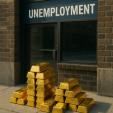Cole's Market Insights - April 27, 1997
Dow Industrials Rally But Other indexes Falter
Helped by a big jump in IBM because of better than expected earnings, the Dow Industrials jumped 173 points on Tuesday. It briefly exceeded 6900 intra day Wednesday before pulling back. By week's end the venerable Dow had risen a modest 35 points, or 0.5% as fear of additional Fed rate hikes started to offset the euphoria over first quarter earnings.
Unfortunately, the Dow's strength again failed to lift the broader market The interest-sensitive Dow Utilities dropped more than 1.7%. The S&P MidCap Index fell 1.5%. The Russell 2000 Index of small cap stocks skidded 1.7%. The NASDAQ decreased 1.1% despite a strong showing by Microsoft.
These divergences have persisted for a long time. Many of the worst bear markets of years past were preceded by similar trends. Emblematic is the powerful 1971-73 bull market which saw great strength in a small group of "nifty-fifty" issues while most stocks languished. In the ensuing bear market, the Dow Industrials skidded nearly 50% in less than 2 years while many more speculative issues plunged 75% or more. The powerful bull run that preceded the 1987 crash also was dominated by big-cap issues.
|
How severe the developing bear market will turn out to be is very |
Bullion Stabilizes, Gold Stocks Continue to Plunge
After a steep drop the previous 7 days, COMEX nearby gold futures rose 90 cents to $342.40 last week. But gold stocks continued to plunge. The XAU index of major North American producers fell 5 points to 92. This is the lowest level since late 1993 and about 40% under the February 1996 peak. Gold stock weakness reflects continued investor disenchantment in the wake of the BRE-X fiasco. The investment community remains very negative on the gold price outlook amid reports that some western central banks are striving to end or substantially reduce bullion's role as a monetary reserve asset. Gold investor sentiment is as bad today as it has ever been.
Gold Will Rise Again
In the wake of a savage 15 month bear market investors who should know better are dumping gold shares on the theory that the central banks with their huge holdings will forever be able to keep bullion depressed. Back in 1975 at the bottom of the century's second-worst equity bear market, the consensus opinion was that a new "ice age" for equities had dawned. "Everybody" knew the stock market would never again go up in a big way. The consensus was wrong then about stocks and is just as wrong today re: gold.
History shows that central banks can only control the gold price if investor demand is low. In the 1960s, they successfully suppressed gold for a number of years via the London Gold Pool. But this effort ultimately failed when investor demand took off in the early 1970s as OPEC hiked oil prices, the U.S. was defeated in Vietnam, and a sitting President was forced to resign.
Today's depressed gold prices reflect a "what me worry" attitude by investors around the world at least as much as central bank selling. The strong dollar has also been a major negative. Confidence in the ability of the global economic and financial system and its institutions to meet all possible challenges is as high as it has ever been.
|
Is this confidence justified? If the recent past is prologue |
But for those inclined to doubt that the current "perfect" investment and economic environment can continue much longer, gold has never been more attractive. As mentioned earlier, investor sentiment re: the yellow metal is as negative as it has ever been. The current 20 to 1 Dow/gold ratio is the same as it was at the beginning of the huge 1970s gold bull. The XAU is at record lows relative to such broad averages as the Dow Industrials and the S&P 500.
On a more cautionary note, the XAU/gold ratio still is about 10% higher than it was the beginning of the powerful 1993 gold bull. And it is too early to tell if bullion has finally troughed. So there still is considerable risk for investors in gold and gold shares. But isn't this always the case at or near major bottoms? One can never be 100% sure of a trough except in hindsight. But for anybody who believes the current investment, political, and economic environment is bound to change for the worse before long, today's risk/reward equation for gold bullion and gold stocks is starting to look very attractive indeed.

















